Principles of Corporate Finance: Investment Portfolio Analysis Report
VerifiedAdded on 2020/07/22
|17
|4869
|34
Report
AI Summary
This report provides an executive summary and detailed analysis of investment strategies within the principles of corporate finance. It examines the UK's economic situation, including GDP, inflation, and taxation, and presents sectorial reports for companies like Cairn Energy Plc, Sports Direct International Plc, and Inmarsat Plc. The report delves into investment rationale, assesses financial performance, and performs share valuation using various methods. It includes ratio analysis, covariance and correlation analysis, and the application of the Capital Asset Pricing Model (CAPM) to determine expected returns and portfolio performance. The report concludes with an investment strategy that aims to generate adequate returns, considering the market's volatility and potential impacts of trade wars.
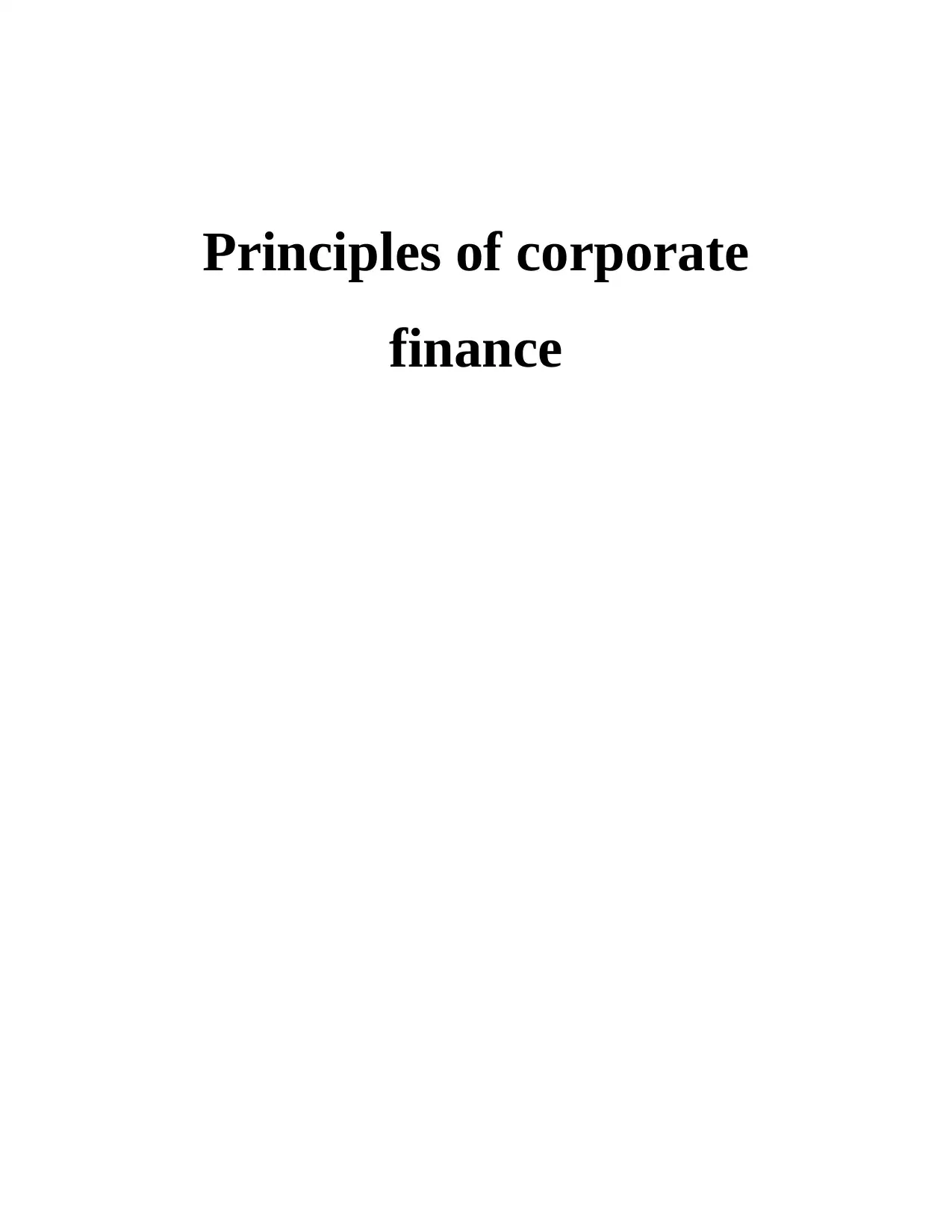
Principles of corporate
finance
finance
Paraphrase This Document
Need a fresh take? Get an instant paraphrase of this document with our AI Paraphraser

Executive Summary
Investment is required to be made in the securities so that adequate returns should be
achieved by the investors. Price and valuation of shares plays crucial role in the company in
order to accomplish more market base in the best possible manner. Furthermore, investment
should be made in highly stable securities so that good average returns may be generated and
investors may be benefited with much ease. Valuation of shares are required to be made by
company so that both investors and organisation can assess market value of per share in the best
possible way. The price at which security of Sports Direct International Plc is 148.70 and on the
other hand, Inmarsat Plc is 5.29. While, Cairn Energy Plc has 308.96 of share price at the end of
month. Moreover, the facts about the investment of 2 million is required to be made. It can be
analysed that investors would get lower returns in the short-run and will get adequate average
returns in the long-run. Furthermore, securities should be evaluated in effective manner so that
investors may garner greater returns. Moreover, various methods of valuation of shares are also
important in selecting securities yielding maximum returns. It is also required that company
should perform well so that adequate returns can be provided to investors and as such, more
investment may be made by them which would be beneficial for the company to effectively
finance activities in the best possible way. Furthermore, financial ratios also help to assess
performance of the company and investors can rely on the same.
Investment is required to be made in the securities so that adequate returns should be
achieved by the investors. Price and valuation of shares plays crucial role in the company in
order to accomplish more market base in the best possible manner. Furthermore, investment
should be made in highly stable securities so that good average returns may be generated and
investors may be benefited with much ease. Valuation of shares are required to be made by
company so that both investors and organisation can assess market value of per share in the best
possible way. The price at which security of Sports Direct International Plc is 148.70 and on the
other hand, Inmarsat Plc is 5.29. While, Cairn Energy Plc has 308.96 of share price at the end of
month. Moreover, the facts about the investment of 2 million is required to be made. It can be
analysed that investors would get lower returns in the short-run and will get adequate average
returns in the long-run. Furthermore, securities should be evaluated in effective manner so that
investors may garner greater returns. Moreover, various methods of valuation of shares are also
important in selecting securities yielding maximum returns. It is also required that company
should perform well so that adequate returns can be provided to investors and as such, more
investment may be made by them which would be beneficial for the company to effectively
finance activities in the best possible way. Furthermore, financial ratios also help to assess
performance of the company and investors can rely on the same.
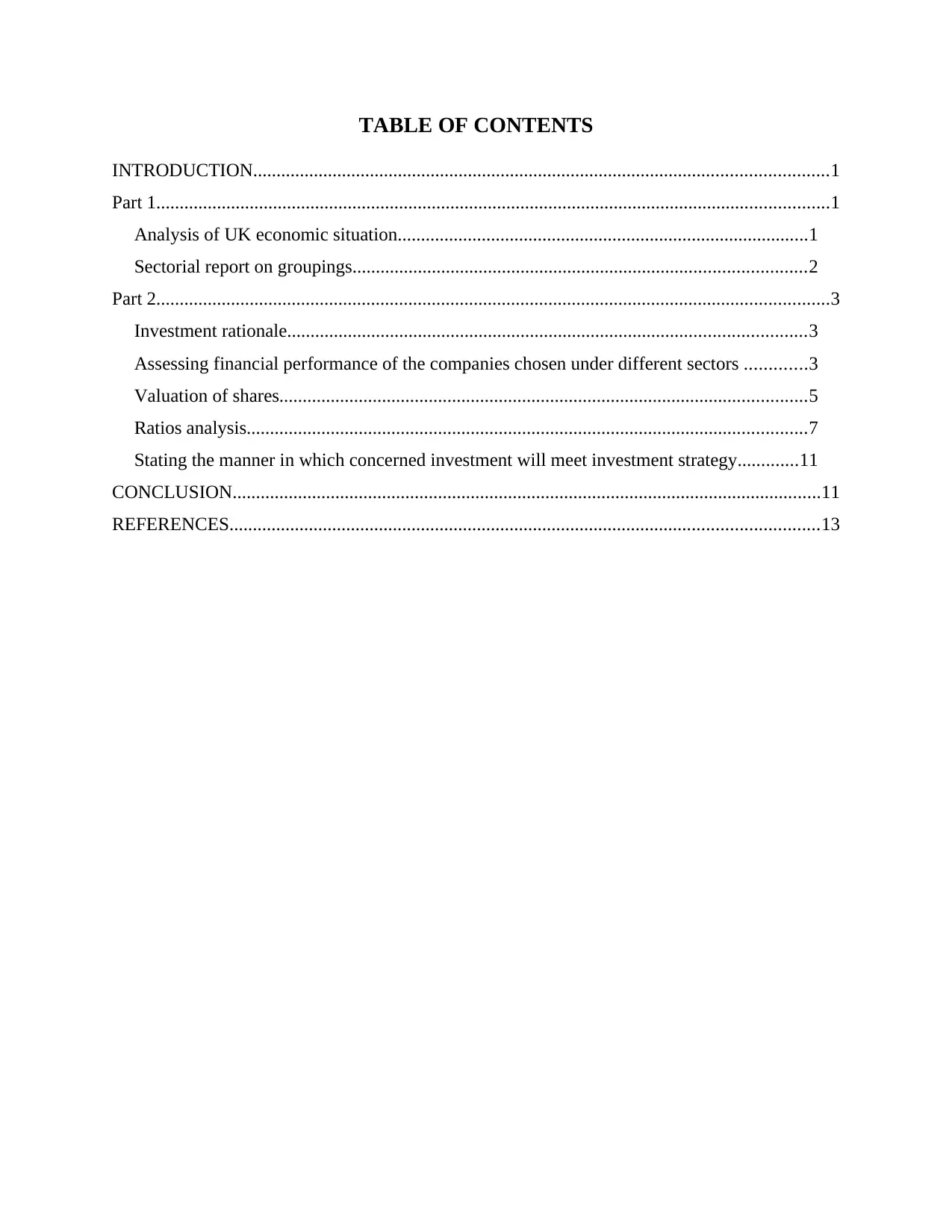
TABLE OF CONTENTS
INTRODUCTION...........................................................................................................................1
Part 1................................................................................................................................................1
Analysis of UK economic situation........................................................................................1
Sectorial report on groupings.................................................................................................2
Part 2................................................................................................................................................3
Investment rationale...............................................................................................................3
Assessing financial performance of the companies chosen under different sectors .............3
Valuation of shares.................................................................................................................5
Ratios analysis........................................................................................................................7
Stating the manner in which concerned investment will meet investment strategy.............11
CONCLUSION..............................................................................................................................11
REFERENCES..............................................................................................................................13
INTRODUCTION...........................................................................................................................1
Part 1................................................................................................................................................1
Analysis of UK economic situation........................................................................................1
Sectorial report on groupings.................................................................................................2
Part 2................................................................................................................................................3
Investment rationale...............................................................................................................3
Assessing financial performance of the companies chosen under different sectors .............3
Valuation of shares.................................................................................................................5
Ratios analysis........................................................................................................................7
Stating the manner in which concerned investment will meet investment strategy.............11
CONCLUSION..............................................................................................................................11
REFERENCES..............................................................................................................................13
⊘ This is a preview!⊘
Do you want full access?
Subscribe today to unlock all pages.

Trusted by 1+ million students worldwide
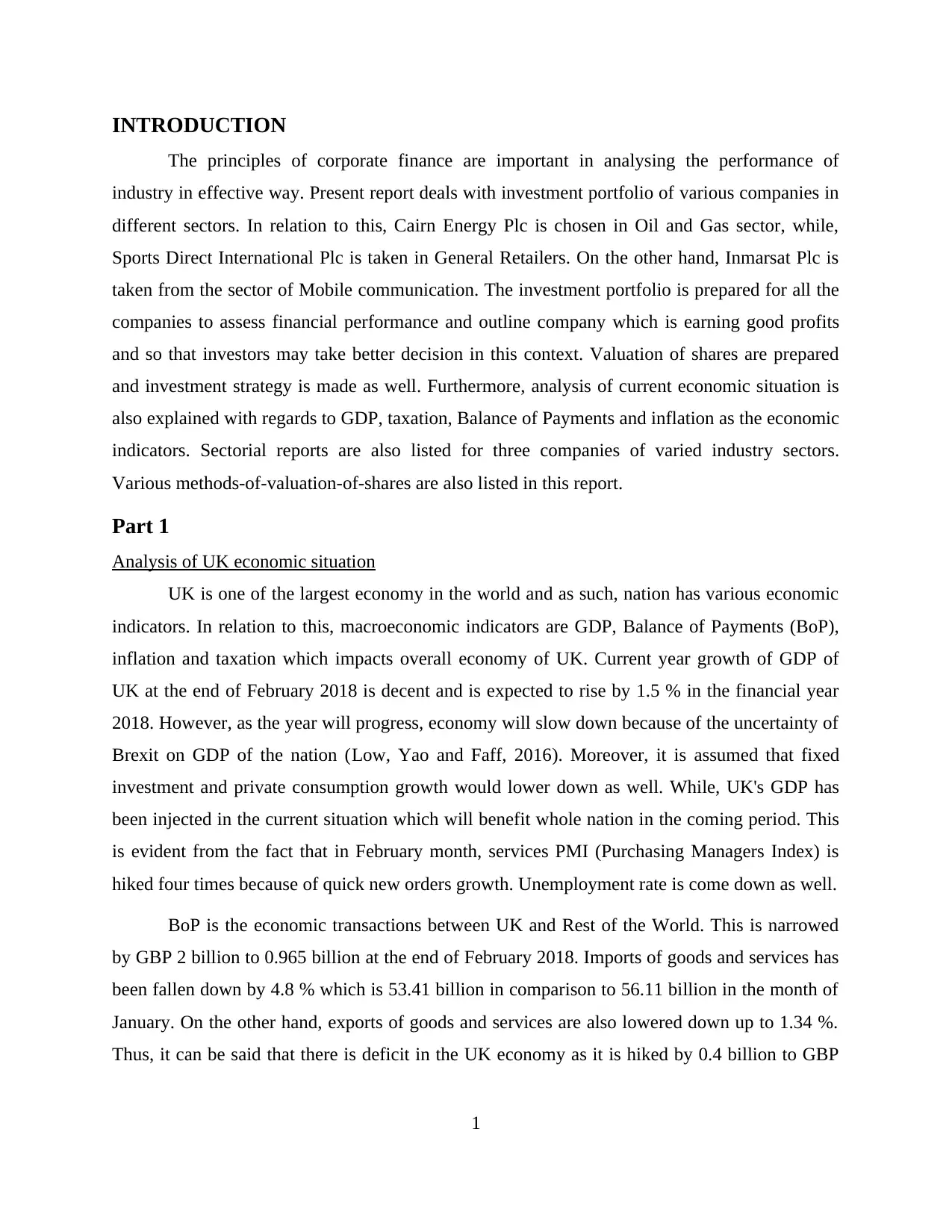
INTRODUCTION
The principles of corporate finance are important in analysing the performance of
industry in effective way. Present report deals with investment portfolio of various companies in
different sectors. In relation to this, Cairn Energy Plc is chosen in Oil and Gas sector, while,
Sports Direct International Plc is taken in General Retailers. On the other hand, Inmarsat Plc is
taken from the sector of Mobile communication. The investment portfolio is prepared for all the
companies to assess financial performance and outline company which is earning good profits
and so that investors may take better decision in this context. Valuation of shares are prepared
and investment strategy is made as well. Furthermore, analysis of current economic situation is
also explained with regards to GDP, taxation, Balance of Payments and inflation as the economic
indicators. Sectorial reports are also listed for three companies of varied industry sectors.
Various methods-of-valuation-of-shares are also listed in this report.
Part 1
Analysis of UK economic situation
UK is one of the largest economy in the world and as such, nation has various economic
indicators. In relation to this, macroeconomic indicators are GDP, Balance of Payments (BoP),
inflation and taxation which impacts overall economy of UK. Current year growth of GDP of
UK at the end of February 2018 is decent and is expected to rise by 1.5 % in the financial year
2018. However, as the year will progress, economy will slow down because of the uncertainty of
Brexit on GDP of the nation (Low, Yao and Faff, 2016). Moreover, it is assumed that fixed
investment and private consumption growth would lower down as well. While, UK's GDP has
been injected in the current situation which will benefit whole nation in the coming period. This
is evident from the fact that in February month, services PMI (Purchasing Managers Index) is
hiked four times because of quick new orders growth. Unemployment rate is come down as well.
BoP is the economic transactions between UK and Rest of the World. This is narrowed
by GBP 2 billion to 0.965 billion at the end of February 2018. Imports of goods and services has
been fallen down by 4.8 % which is 53.41 billion in comparison to 56.11 billion in the month of
January. On the other hand, exports of goods and services are also lowered down up to 1.34 %.
Thus, it can be said that there is deficit in the UK economy as it is hiked by 0.4 billion to GBP
1
The principles of corporate finance are important in analysing the performance of
industry in effective way. Present report deals with investment portfolio of various companies in
different sectors. In relation to this, Cairn Energy Plc is chosen in Oil and Gas sector, while,
Sports Direct International Plc is taken in General Retailers. On the other hand, Inmarsat Plc is
taken from the sector of Mobile communication. The investment portfolio is prepared for all the
companies to assess financial performance and outline company which is earning good profits
and so that investors may take better decision in this context. Valuation of shares are prepared
and investment strategy is made as well. Furthermore, analysis of current economic situation is
also explained with regards to GDP, taxation, Balance of Payments and inflation as the economic
indicators. Sectorial reports are also listed for three companies of varied industry sectors.
Various methods-of-valuation-of-shares are also listed in this report.
Part 1
Analysis of UK economic situation
UK is one of the largest economy in the world and as such, nation has various economic
indicators. In relation to this, macroeconomic indicators are GDP, Balance of Payments (BoP),
inflation and taxation which impacts overall economy of UK. Current year growth of GDP of
UK at the end of February 2018 is decent and is expected to rise by 1.5 % in the financial year
2018. However, as the year will progress, economy will slow down because of the uncertainty of
Brexit on GDP of the nation (Low, Yao and Faff, 2016). Moreover, it is assumed that fixed
investment and private consumption growth would lower down as well. While, UK's GDP has
been injected in the current situation which will benefit whole nation in the coming period. This
is evident from the fact that in February month, services PMI (Purchasing Managers Index) is
hiked four times because of quick new orders growth. Unemployment rate is come down as well.
BoP is the economic transactions between UK and Rest of the World. This is narrowed
by GBP 2 billion to 0.965 billion at the end of February 2018. Imports of goods and services has
been fallen down by 4.8 % which is 53.41 billion in comparison to 56.11 billion in the month of
January. On the other hand, exports of goods and services are also lowered down up to 1.34 %.
Thus, it can be said that there is deficit in the UK economy as it is hiked by 0.4 billion to GBP
1
Paraphrase This Document
Need a fresh take? Get an instant paraphrase of this document with our AI Paraphraser
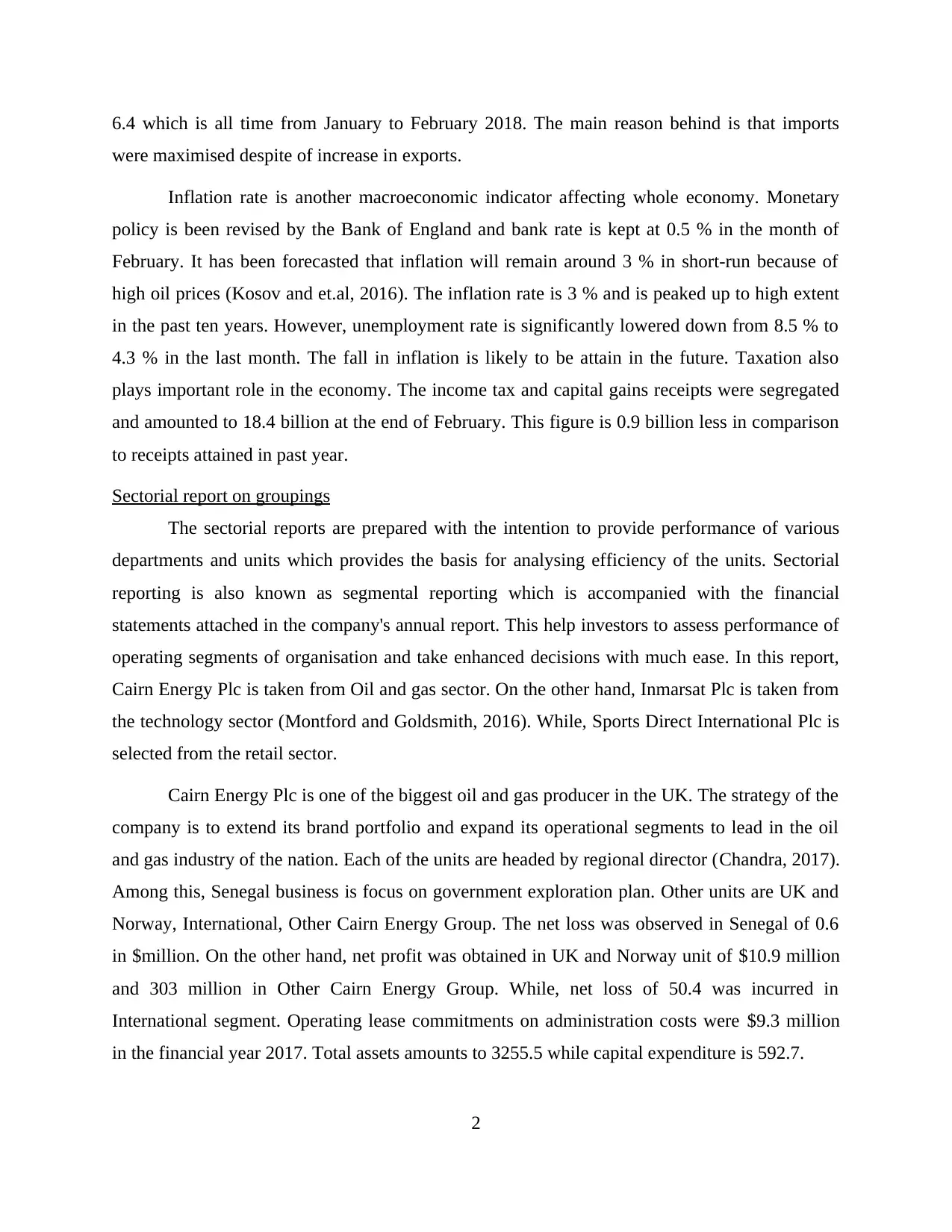
6.4 which is all time from January to February 2018. The main reason behind is that imports
were maximised despite of increase in exports.
Inflation rate is another macroeconomic indicator affecting whole economy. Monetary
policy is been revised by the Bank of England and bank rate is kept at 0.5 % in the month of
February. It has been forecasted that inflation will remain around 3 % in short-run because of
high oil prices (Kosov and et.al, 2016). The inflation rate is 3 % and is peaked up to high extent
in the past ten years. However, unemployment rate is significantly lowered down from 8.5 % to
4.3 % in the last month. The fall in inflation is likely to be attain in the future. Taxation also
plays important role in the economy. The income tax and capital gains receipts were segregated
and amounted to 18.4 billion at the end of February. This figure is 0.9 billion less in comparison
to receipts attained in past year.
Sectorial report on groupings
The sectorial reports are prepared with the intention to provide performance of various
departments and units which provides the basis for analysing efficiency of the units. Sectorial
reporting is also known as segmental reporting which is accompanied with the financial
statements attached in the company's annual report. This help investors to assess performance of
operating segments of organisation and take enhanced decisions with much ease. In this report,
Cairn Energy Plc is taken from Oil and gas sector. On the other hand, Inmarsat Plc is taken from
the technology sector (Montford and Goldsmith, 2016). While, Sports Direct International Plc is
selected from the retail sector.
Cairn Energy Plc is one of the biggest oil and gas producer in the UK. The strategy of the
company is to extend its brand portfolio and expand its operational segments to lead in the oil
and gas industry of the nation. Each of the units are headed by regional director (Chandra, 2017).
Among this, Senegal business is focus on government exploration plan. Other units are UK and
Norway, International, Other Cairn Energy Group. The net loss was observed in Senegal of 0.6
in $million. On the other hand, net profit was obtained in UK and Norway unit of $10.9 million
and 303 million in Other Cairn Energy Group. While, net loss of 50.4 was incurred in
International segment. Operating lease commitments on administration costs were $9.3 million
in the financial year 2017. Total assets amounts to 3255.5 while capital expenditure is 592.7.
2
were maximised despite of increase in exports.
Inflation rate is another macroeconomic indicator affecting whole economy. Monetary
policy is been revised by the Bank of England and bank rate is kept at 0.5 % in the month of
February. It has been forecasted that inflation will remain around 3 % in short-run because of
high oil prices (Kosov and et.al, 2016). The inflation rate is 3 % and is peaked up to high extent
in the past ten years. However, unemployment rate is significantly lowered down from 8.5 % to
4.3 % in the last month. The fall in inflation is likely to be attain in the future. Taxation also
plays important role in the economy. The income tax and capital gains receipts were segregated
and amounted to 18.4 billion at the end of February. This figure is 0.9 billion less in comparison
to receipts attained in past year.
Sectorial report on groupings
The sectorial reports are prepared with the intention to provide performance of various
departments and units which provides the basis for analysing efficiency of the units. Sectorial
reporting is also known as segmental reporting which is accompanied with the financial
statements attached in the company's annual report. This help investors to assess performance of
operating segments of organisation and take enhanced decisions with much ease. In this report,
Cairn Energy Plc is taken from Oil and gas sector. On the other hand, Inmarsat Plc is taken from
the technology sector (Montford and Goldsmith, 2016). While, Sports Direct International Plc is
selected from the retail sector.
Cairn Energy Plc is one of the biggest oil and gas producer in the UK. The strategy of the
company is to extend its brand portfolio and expand its operational segments to lead in the oil
and gas industry of the nation. Each of the units are headed by regional director (Chandra, 2017).
Among this, Senegal business is focus on government exploration plan. Other units are UK and
Norway, International, Other Cairn Energy Group. The net loss was observed in Senegal of 0.6
in $million. On the other hand, net profit was obtained in UK and Norway unit of $10.9 million
and 303 million in Other Cairn Energy Group. While, net loss of 50.4 was incurred in
International segment. Operating lease commitments on administration costs were $9.3 million
in the financial year 2017. Total assets amounts to 3255.5 while capital expenditure is 592.7.
2
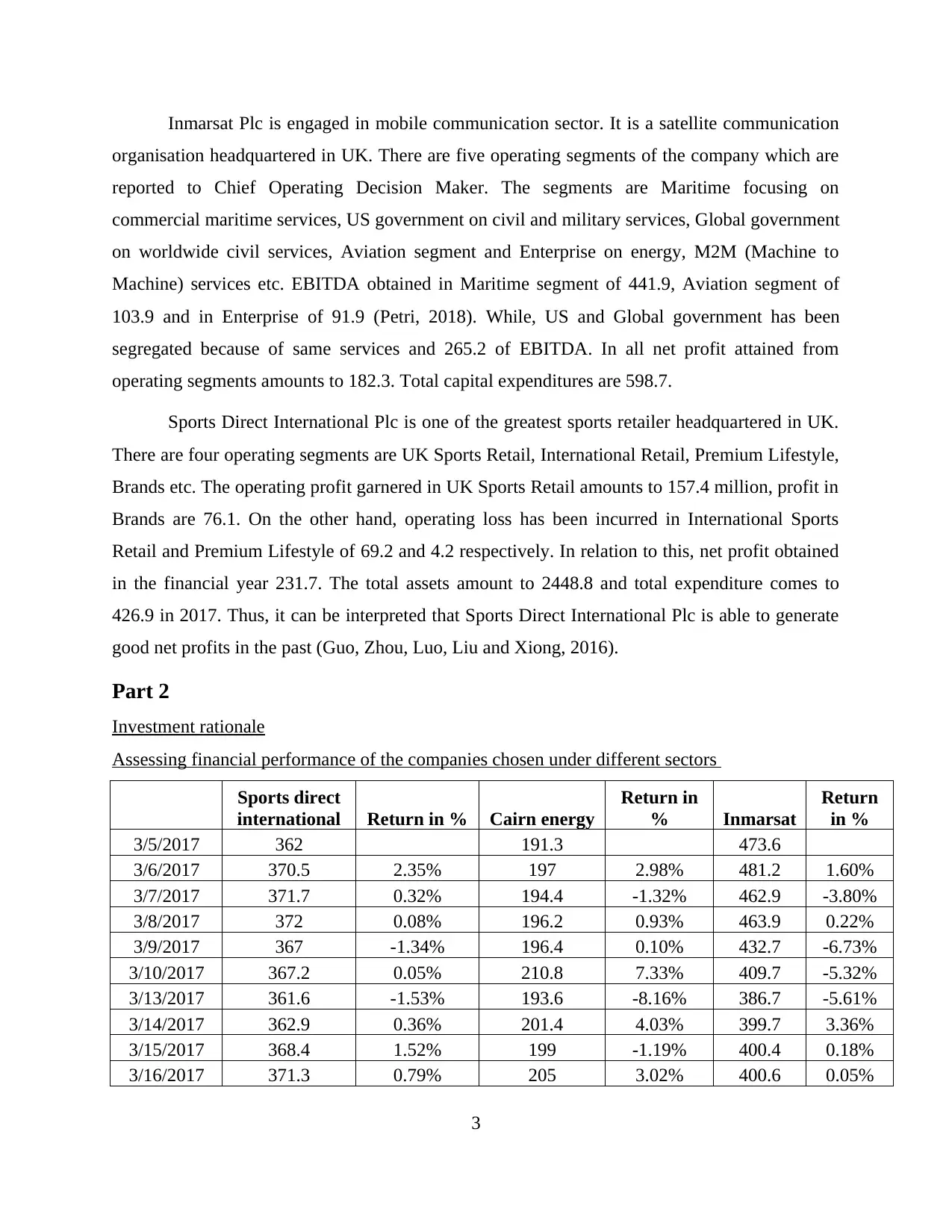
Inmarsat Plc is engaged in mobile communication sector. It is a satellite communication
organisation headquartered in UK. There are five operating segments of the company which are
reported to Chief Operating Decision Maker. The segments are Maritime focusing on
commercial maritime services, US government on civil and military services, Global government
on worldwide civil services, Aviation segment and Enterprise on energy, M2M (Machine to
Machine) services etc. EBITDA obtained in Maritime segment of 441.9, Aviation segment of
103.9 and in Enterprise of 91.9 (Petri, 2018). While, US and Global government has been
segregated because of same services and 265.2 of EBITDA. In all net profit attained from
operating segments amounts to 182.3. Total capital expenditures are 598.7.
Sports Direct International Plc is one of the greatest sports retailer headquartered in UK.
There are four operating segments are UK Sports Retail, International Retail, Premium Lifestyle,
Brands etc. The operating profit garnered in UK Sports Retail amounts to 157.4 million, profit in
Brands are 76.1. On the other hand, operating loss has been incurred in International Sports
Retail and Premium Lifestyle of 69.2 and 4.2 respectively. In relation to this, net profit obtained
in the financial year 231.7. The total assets amount to 2448.8 and total expenditure comes to
426.9 in 2017. Thus, it can be interpreted that Sports Direct International Plc is able to generate
good net profits in the past (Guo, Zhou, Luo, Liu and Xiong, 2016).
Part 2
Investment rationale
Assessing financial performance of the companies chosen under different sectors
Sports direct
international Return in % Cairn energy
Return in
% Inmarsat
Return
in %
3/5/2017 362 191.3 473.6
3/6/2017 370.5 2.35% 197 2.98% 481.2 1.60%
3/7/2017 371.7 0.32% 194.4 -1.32% 462.9 -3.80%
3/8/2017 372 0.08% 196.2 0.93% 463.9 0.22%
3/9/2017 367 -1.34% 196.4 0.10% 432.7 -6.73%
3/10/2017 367.2 0.05% 210.8 7.33% 409.7 -5.32%
3/13/2017 361.6 -1.53% 193.6 -8.16% 386.7 -5.61%
3/14/2017 362.9 0.36% 201.4 4.03% 399.7 3.36%
3/15/2017 368.4 1.52% 199 -1.19% 400.4 0.18%
3/16/2017 371.3 0.79% 205 3.02% 400.6 0.05%
3
organisation headquartered in UK. There are five operating segments of the company which are
reported to Chief Operating Decision Maker. The segments are Maritime focusing on
commercial maritime services, US government on civil and military services, Global government
on worldwide civil services, Aviation segment and Enterprise on energy, M2M (Machine to
Machine) services etc. EBITDA obtained in Maritime segment of 441.9, Aviation segment of
103.9 and in Enterprise of 91.9 (Petri, 2018). While, US and Global government has been
segregated because of same services and 265.2 of EBITDA. In all net profit attained from
operating segments amounts to 182.3. Total capital expenditures are 598.7.
Sports Direct International Plc is one of the greatest sports retailer headquartered in UK.
There are four operating segments are UK Sports Retail, International Retail, Premium Lifestyle,
Brands etc. The operating profit garnered in UK Sports Retail amounts to 157.4 million, profit in
Brands are 76.1. On the other hand, operating loss has been incurred in International Sports
Retail and Premium Lifestyle of 69.2 and 4.2 respectively. In relation to this, net profit obtained
in the financial year 231.7. The total assets amount to 2448.8 and total expenditure comes to
426.9 in 2017. Thus, it can be interpreted that Sports Direct International Plc is able to generate
good net profits in the past (Guo, Zhou, Luo, Liu and Xiong, 2016).
Part 2
Investment rationale
Assessing financial performance of the companies chosen under different sectors
Sports direct
international Return in % Cairn energy
Return in
% Inmarsat
Return
in %
3/5/2017 362 191.3 473.6
3/6/2017 370.5 2.35% 197 2.98% 481.2 1.60%
3/7/2017 371.7 0.32% 194.4 -1.32% 462.9 -3.80%
3/8/2017 372 0.08% 196.2 0.93% 463.9 0.22%
3/9/2017 367 -1.34% 196.4 0.10% 432.7 -6.73%
3/10/2017 367.2 0.05% 210.8 7.33% 409.7 -5.32%
3/13/2017 361.6 -1.53% 193.6 -8.16% 386.7 -5.61%
3/14/2017 362.9 0.36% 201.4 4.03% 399.7 3.36%
3/15/2017 368.4 1.52% 199 -1.19% 400.4 0.18%
3/16/2017 371.3 0.79% 205 3.02% 400.6 0.05%
3
⊘ This is a preview!⊘
Do you want full access?
Subscribe today to unlock all pages.

Trusted by 1+ million students worldwide
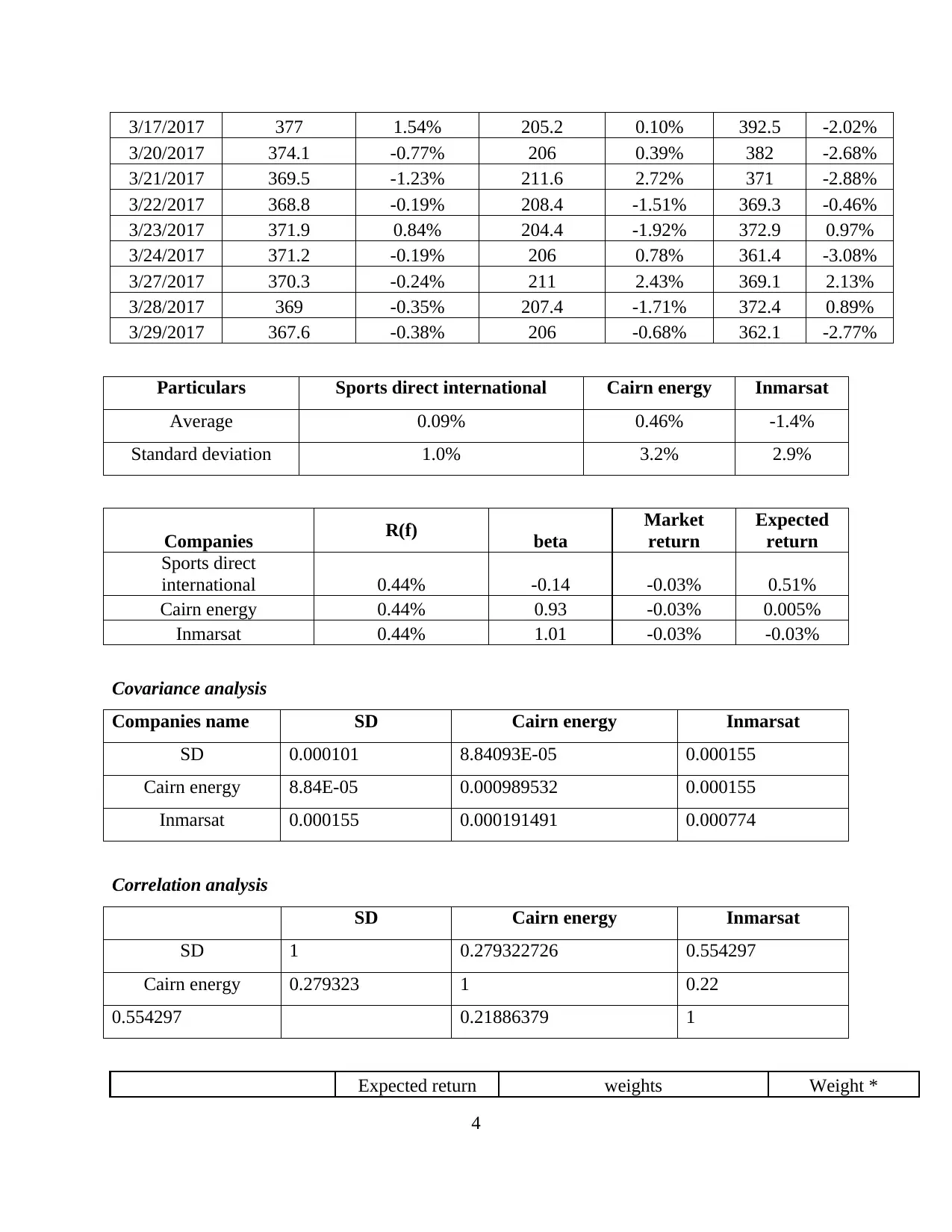
3/17/2017 377 1.54% 205.2 0.10% 392.5 -2.02%
3/20/2017 374.1 -0.77% 206 0.39% 382 -2.68%
3/21/2017 369.5 -1.23% 211.6 2.72% 371 -2.88%
3/22/2017 368.8 -0.19% 208.4 -1.51% 369.3 -0.46%
3/23/2017 371.9 0.84% 204.4 -1.92% 372.9 0.97%
3/24/2017 371.2 -0.19% 206 0.78% 361.4 -3.08%
3/27/2017 370.3 -0.24% 211 2.43% 369.1 2.13%
3/28/2017 369 -0.35% 207.4 -1.71% 372.4 0.89%
3/29/2017 367.6 -0.38% 206 -0.68% 362.1 -2.77%
Particulars Sports direct international Cairn energy Inmarsat
Average 0.09% 0.46% -1.4%
Standard deviation 1.0% 3.2% 2.9%
Companies R(f) beta
Market
return
Expected
return
Sports direct
international 0.44% -0.14 -0.03% 0.51%
Cairn energy 0.44% 0.93 -0.03% 0.005%
Inmarsat 0.44% 1.01 -0.03% -0.03%
Covariance analysis
Companies name SD Cairn energy Inmarsat
SD 0.000101 8.84093E-05 0.000155
Cairn energy 8.84E-05 0.000989532 0.000155
Inmarsat 0.000155 0.000191491 0.000774
Correlation analysis
SD Cairn energy Inmarsat
SD 1 0.279322726 0.554297
Cairn energy 0.279323 1 0.22
0.554297 0.21886379 1
Expected return weights Weight *
4
3/20/2017 374.1 -0.77% 206 0.39% 382 -2.68%
3/21/2017 369.5 -1.23% 211.6 2.72% 371 -2.88%
3/22/2017 368.8 -0.19% 208.4 -1.51% 369.3 -0.46%
3/23/2017 371.9 0.84% 204.4 -1.92% 372.9 0.97%
3/24/2017 371.2 -0.19% 206 0.78% 361.4 -3.08%
3/27/2017 370.3 -0.24% 211 2.43% 369.1 2.13%
3/28/2017 369 -0.35% 207.4 -1.71% 372.4 0.89%
3/29/2017 367.6 -0.38% 206 -0.68% 362.1 -2.77%
Particulars Sports direct international Cairn energy Inmarsat
Average 0.09% 0.46% -1.4%
Standard deviation 1.0% 3.2% 2.9%
Companies R(f) beta
Market
return
Expected
return
Sports direct
international 0.44% -0.14 -0.03% 0.51%
Cairn energy 0.44% 0.93 -0.03% 0.005%
Inmarsat 0.44% 1.01 -0.03% -0.03%
Covariance analysis
Companies name SD Cairn energy Inmarsat
SD 0.000101 8.84093E-05 0.000155
Cairn energy 8.84E-05 0.000989532 0.000155
Inmarsat 0.000155 0.000191491 0.000774
Correlation analysis
SD Cairn energy Inmarsat
SD 1 0.279322726 0.554297
Cairn energy 0.279323 1 0.22
0.554297 0.21886379 1
Expected return weights Weight *
4
Paraphrase This Document
Need a fresh take? Get an instant paraphrase of this document with our AI Paraphraser
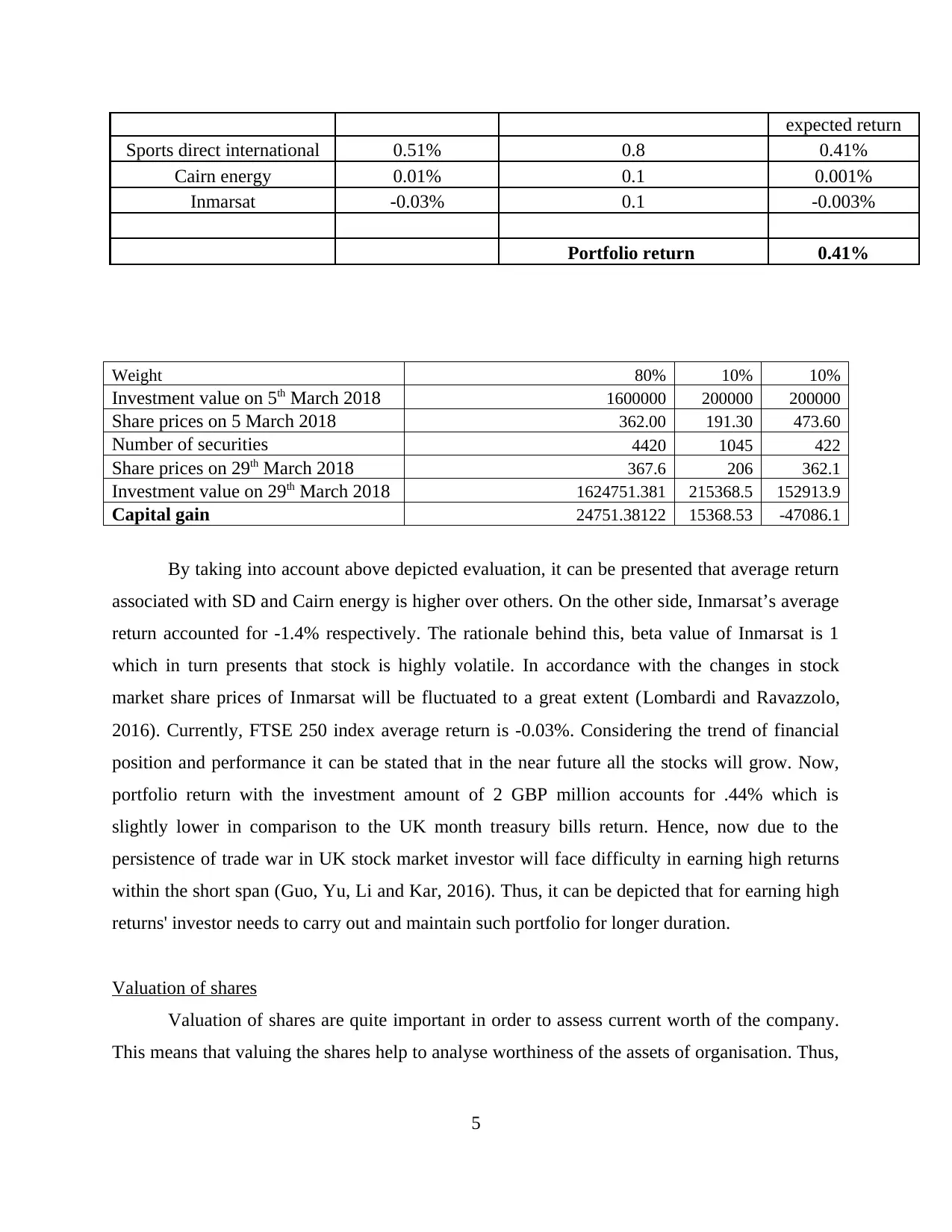
expected return
Sports direct international 0.51% 0.8 0.41%
Cairn energy 0.01% 0.1 0.001%
Inmarsat -0.03% 0.1 -0.003%
Portfolio return 0.41%
Weight 80% 10% 10%
Investment value on 5th March 2018 1600000 200000 200000
Share prices on 5 March 2018 362.00 191.30 473.60
Number of securities 4420 1045 422
Share prices on 29th March 2018 367.6 206 362.1
Investment value on 29th March 2018 1624751.381 215368.5 152913.9
Capital gain 24751.38122 15368.53 -47086.1
By taking into account above depicted evaluation, it can be presented that average return
associated with SD and Cairn energy is higher over others. On the other side, Inmarsat’s average
return accounted for -1.4% respectively. The rationale behind this, beta value of Inmarsat is 1
which in turn presents that stock is highly volatile. In accordance with the changes in stock
market share prices of Inmarsat will be fluctuated to a great extent (Lombardi and Ravazzolo,
2016). Currently, FTSE 250 index average return is -0.03%. Considering the trend of financial
position and performance it can be stated that in the near future all the stocks will grow. Now,
portfolio return with the investment amount of 2 GBP million accounts for .44% which is
slightly lower in comparison to the UK month treasury bills return. Hence, now due to the
persistence of trade war in UK stock market investor will face difficulty in earning high returns
within the short span (Guo, Yu, Li and Kar, 2016). Thus, it can be depicted that for earning high
returns' investor needs to carry out and maintain such portfolio for longer duration.
Valuation of shares
Valuation of shares are quite important in order to assess current worth of the company.
This means that valuing the shares help to analyse worthiness of the assets of organisation. Thus,
5
Sports direct international 0.51% 0.8 0.41%
Cairn energy 0.01% 0.1 0.001%
Inmarsat -0.03% 0.1 -0.003%
Portfolio return 0.41%
Weight 80% 10% 10%
Investment value on 5th March 2018 1600000 200000 200000
Share prices on 5 March 2018 362.00 191.30 473.60
Number of securities 4420 1045 422
Share prices on 29th March 2018 367.6 206 362.1
Investment value on 29th March 2018 1624751.381 215368.5 152913.9
Capital gain 24751.38122 15368.53 -47086.1
By taking into account above depicted evaluation, it can be presented that average return
associated with SD and Cairn energy is higher over others. On the other side, Inmarsat’s average
return accounted for -1.4% respectively. The rationale behind this, beta value of Inmarsat is 1
which in turn presents that stock is highly volatile. In accordance with the changes in stock
market share prices of Inmarsat will be fluctuated to a great extent (Lombardi and Ravazzolo,
2016). Currently, FTSE 250 index average return is -0.03%. Considering the trend of financial
position and performance it can be stated that in the near future all the stocks will grow. Now,
portfolio return with the investment amount of 2 GBP million accounts for .44% which is
slightly lower in comparison to the UK month treasury bills return. Hence, now due to the
persistence of trade war in UK stock market investor will face difficulty in earning high returns
within the short span (Guo, Yu, Li and Kar, 2016). Thus, it can be depicted that for earning high
returns' investor needs to carry out and maintain such portfolio for longer duration.
Valuation of shares
Valuation of shares are quite important in order to assess current worth of the company.
This means that valuing the shares help to analyse worthiness of the assets of organisation. Thus,
5

performance of company can be analysed with the help of shares valuation (Swayamjit. 2018).
There are several methods of valuing shares which are listed below-
1. Asset-Backing method
This method implies that shares are valued on internal value of assets. It has further
bifurcation such as ongoing concern and break-up value of the basis of the company. The
ongoing method means that utility of assets are taken for extracting value while in other one,
realisable value is taken for the purpose of valuation of shares.
2. Yield-Basis method
The shares are valued on the basis of yield which is generated from the investments. This
is always expressed in the form of percentage. The valuation is made on profit and dividend
basis. In case of former, average profit is taken and capitalised value is determined by taking rate
of return and number of shares are divided to extract value. While, dividend is taken for deriving
share value (Kashyap, 2016).
3. Fair Value method
This technique of valuing shares on the basis of yield-basis and asset-backing method. It
implies that fair value can be obtained by taking into account intrinsic and yield value and are
taken as average for arriving better valuation of shares.
4. Return on Capital Employed method
Rate of return on capital is taken for the purpose of valuation. This method is taken as
pre-determined expected rate of return. After analysing expected earnings, capital sum of return
is calculated (Bilbao-Terol and et.al, 2016).
5. Price-Earnings Ratio method
This method is ascertained by relating market price of shares with EPS (Earnings Per
Share).
Sports Direct International Plc
The Price-Earnings ratio 13.40 and EPS is 11.1
Therefore, value of share = EPS * Price-Earnings Ratio
6
There are several methods of valuing shares which are listed below-
1. Asset-Backing method
This method implies that shares are valued on internal value of assets. It has further
bifurcation such as ongoing concern and break-up value of the basis of the company. The
ongoing method means that utility of assets are taken for extracting value while in other one,
realisable value is taken for the purpose of valuation of shares.
2. Yield-Basis method
The shares are valued on the basis of yield which is generated from the investments. This
is always expressed in the form of percentage. The valuation is made on profit and dividend
basis. In case of former, average profit is taken and capitalised value is determined by taking rate
of return and number of shares are divided to extract value. While, dividend is taken for deriving
share value (Kashyap, 2016).
3. Fair Value method
This technique of valuing shares on the basis of yield-basis and asset-backing method. It
implies that fair value can be obtained by taking into account intrinsic and yield value and are
taken as average for arriving better valuation of shares.
4. Return on Capital Employed method
Rate of return on capital is taken for the purpose of valuation. This method is taken as
pre-determined expected rate of return. After analysing expected earnings, capital sum of return
is calculated (Bilbao-Terol and et.al, 2016).
5. Price-Earnings Ratio method
This method is ascertained by relating market price of shares with EPS (Earnings Per
Share).
Sports Direct International Plc
The Price-Earnings ratio 13.40 and EPS is 11.1
Therefore, value of share = EPS * Price-Earnings Ratio
6
⊘ This is a preview!⊘
Do you want full access?
Subscribe today to unlock all pages.

Trusted by 1+ million students worldwide
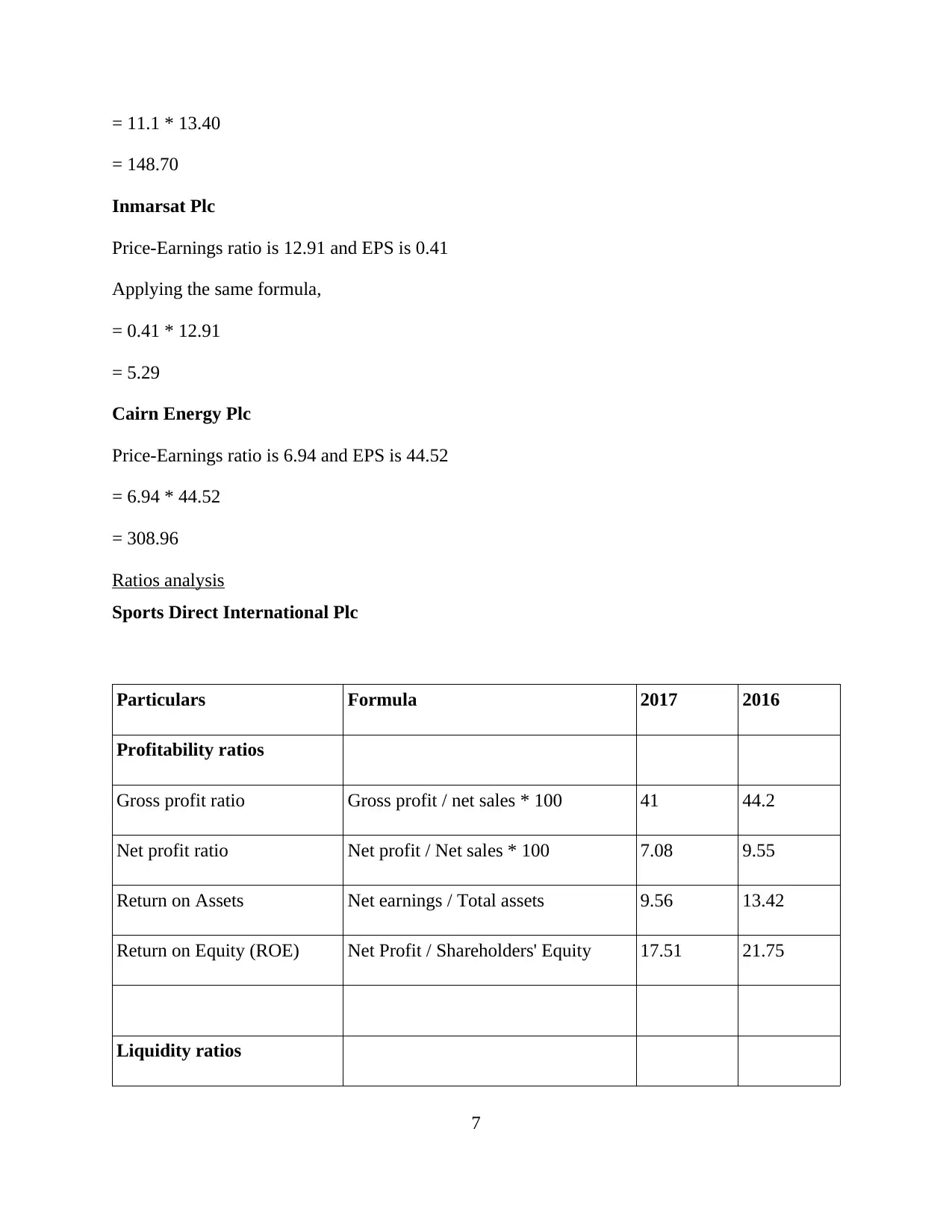
= 11.1 * 13.40
= 148.70
Inmarsat Plc
Price-Earnings ratio is 12.91 and EPS is 0.41
Applying the same formula,
= 0.41 * 12.91
= 5.29
Cairn Energy Plc
Price-Earnings ratio is 6.94 and EPS is 44.52
= 6.94 * 44.52
= 308.96
Ratios analysis
Sports Direct International Plc
Particulars Formula 2017 2016
Profitability ratios
Gross profit ratio Gross profit / net sales * 100 41 44.2
Net profit ratio Net profit / Net sales * 100 7.08 9.55
Return on Assets Net earnings / Total assets 9.56 13.42
Return on Equity (ROE) Net Profit / Shareholders' Equity 17.51 21.75
Liquidity ratios
7
= 148.70
Inmarsat Plc
Price-Earnings ratio is 12.91 and EPS is 0.41
Applying the same formula,
= 0.41 * 12.91
= 5.29
Cairn Energy Plc
Price-Earnings ratio is 6.94 and EPS is 44.52
= 6.94 * 44.52
= 308.96
Ratios analysis
Sports Direct International Plc
Particulars Formula 2017 2016
Profitability ratios
Gross profit ratio Gross profit / net sales * 100 41 44.2
Net profit ratio Net profit / Net sales * 100 7.08 9.55
Return on Assets Net earnings / Total assets 9.56 13.42
Return on Equity (ROE) Net Profit / Shareholders' Equity 17.51 21.75
Liquidity ratios
7
Paraphrase This Document
Need a fresh take? Get an instant paraphrase of this document with our AI Paraphraser
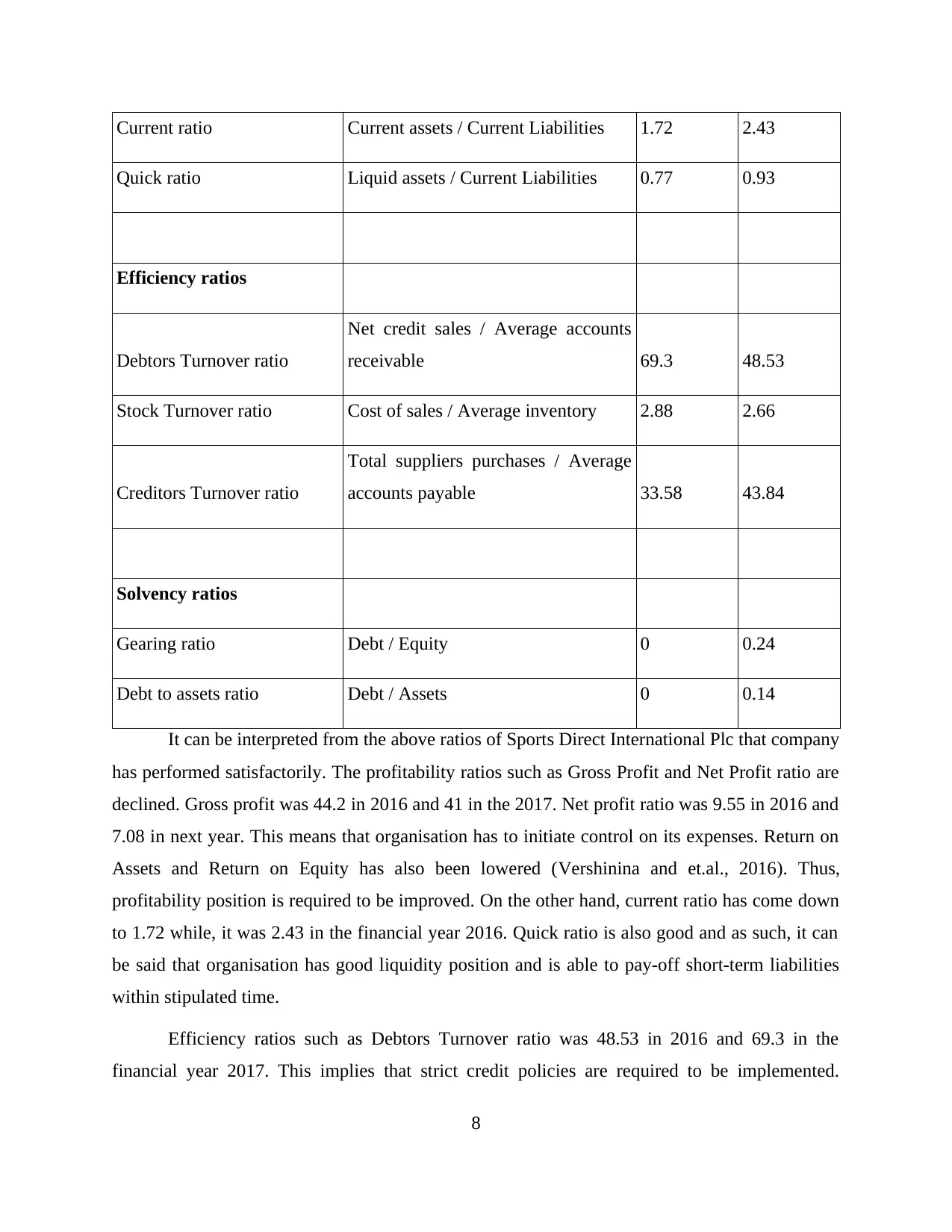
Current ratio Current assets / Current Liabilities 1.72 2.43
Quick ratio Liquid assets / Current Liabilities 0.77 0.93
Efficiency ratios
Debtors Turnover ratio
Net credit sales / Average accounts
receivable 69.3 48.53
Stock Turnover ratio Cost of sales / Average inventory 2.88 2.66
Creditors Turnover ratio
Total suppliers purchases / Average
accounts payable 33.58 43.84
Solvency ratios
Gearing ratio Debt / Equity 0 0.24
Debt to assets ratio Debt / Assets 0 0.14
It can be interpreted from the above ratios of Sports Direct International Plc that company
has performed satisfactorily. The profitability ratios such as Gross Profit and Net Profit ratio are
declined. Gross profit was 44.2 in 2016 and 41 in the 2017. Net profit ratio was 9.55 in 2016 and
7.08 in next year. This means that organisation has to initiate control on its expenses. Return on
Assets and Return on Equity has also been lowered (Vershinina and et.al., 2016). Thus,
profitability position is required to be improved. On the other hand, current ratio has come down
to 1.72 while, it was 2.43 in the financial year 2016. Quick ratio is also good and as such, it can
be said that organisation has good liquidity position and is able to pay-off short-term liabilities
within stipulated time.
Efficiency ratios such as Debtors Turnover ratio was 48.53 in 2016 and 69.3 in the
financial year 2017. This implies that strict credit policies are required to be implemented.
8
Quick ratio Liquid assets / Current Liabilities 0.77 0.93
Efficiency ratios
Debtors Turnover ratio
Net credit sales / Average accounts
receivable 69.3 48.53
Stock Turnover ratio Cost of sales / Average inventory 2.88 2.66
Creditors Turnover ratio
Total suppliers purchases / Average
accounts payable 33.58 43.84
Solvency ratios
Gearing ratio Debt / Equity 0 0.24
Debt to assets ratio Debt / Assets 0 0.14
It can be interpreted from the above ratios of Sports Direct International Plc that company
has performed satisfactorily. The profitability ratios such as Gross Profit and Net Profit ratio are
declined. Gross profit was 44.2 in 2016 and 41 in the 2017. Net profit ratio was 9.55 in 2016 and
7.08 in next year. This means that organisation has to initiate control on its expenses. Return on
Assets and Return on Equity has also been lowered (Vershinina and et.al., 2016). Thus,
profitability position is required to be improved. On the other hand, current ratio has come down
to 1.72 while, it was 2.43 in the financial year 2016. Quick ratio is also good and as such, it can
be said that organisation has good liquidity position and is able to pay-off short-term liabilities
within stipulated time.
Efficiency ratios such as Debtors Turnover ratio was 48.53 in 2016 and 69.3 in the
financial year 2017. This implies that strict credit policies are required to be implemented.
8
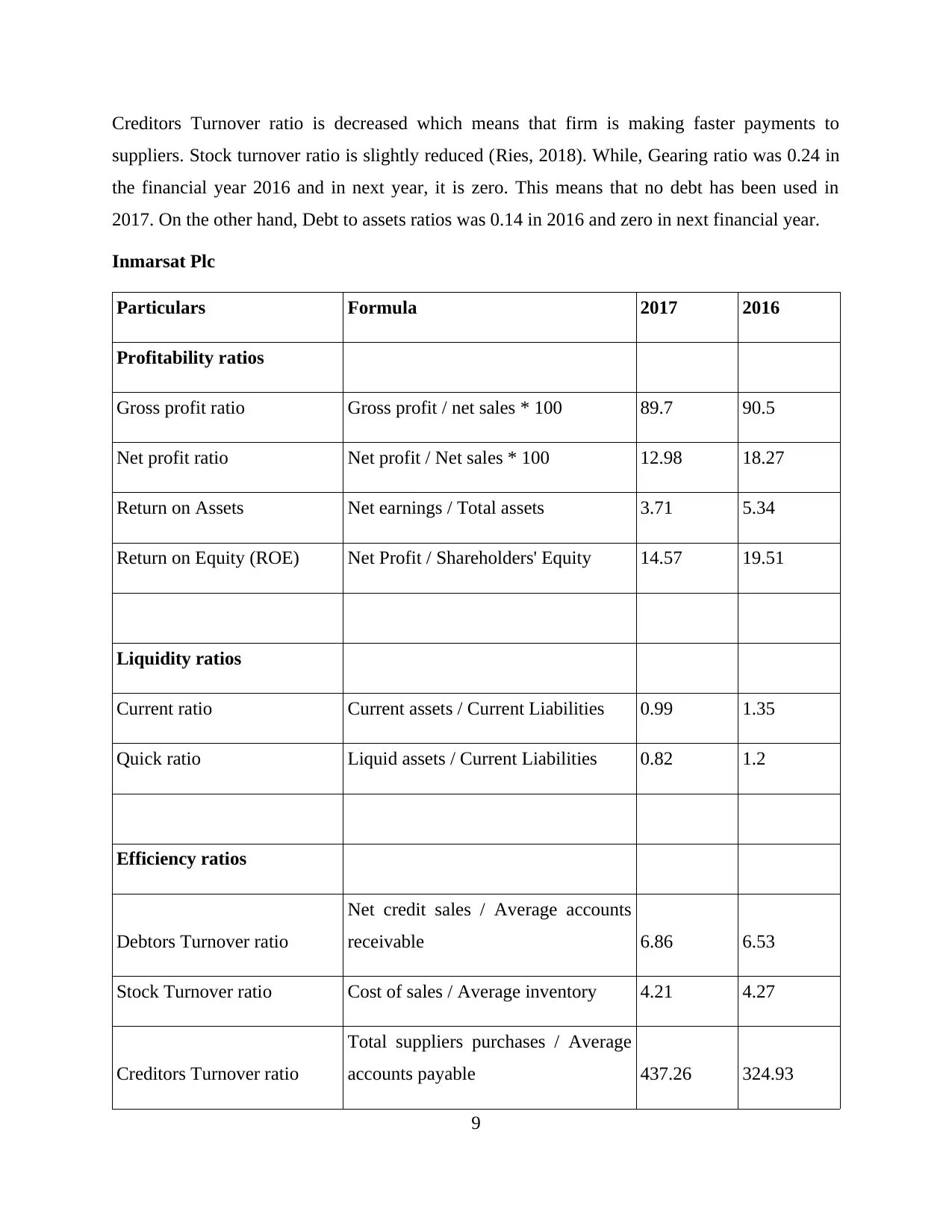
Creditors Turnover ratio is decreased which means that firm is making faster payments to
suppliers. Stock turnover ratio is slightly reduced (Ries, 2018). While, Gearing ratio was 0.24 in
the financial year 2016 and in next year, it is zero. This means that no debt has been used in
2017. On the other hand, Debt to assets ratios was 0.14 in 2016 and zero in next financial year.
Inmarsat Plc
Particulars Formula 2017 2016
Profitability ratios
Gross profit ratio Gross profit / net sales * 100 89.7 90.5
Net profit ratio Net profit / Net sales * 100 12.98 18.27
Return on Assets Net earnings / Total assets 3.71 5.34
Return on Equity (ROE) Net Profit / Shareholders' Equity 14.57 19.51
Liquidity ratios
Current ratio Current assets / Current Liabilities 0.99 1.35
Quick ratio Liquid assets / Current Liabilities 0.82 1.2
Efficiency ratios
Debtors Turnover ratio
Net credit sales / Average accounts
receivable 6.86 6.53
Stock Turnover ratio Cost of sales / Average inventory 4.21 4.27
Creditors Turnover ratio
Total suppliers purchases / Average
accounts payable 437.26 324.93
9
suppliers. Stock turnover ratio is slightly reduced (Ries, 2018). While, Gearing ratio was 0.24 in
the financial year 2016 and in next year, it is zero. This means that no debt has been used in
2017. On the other hand, Debt to assets ratios was 0.14 in 2016 and zero in next financial year.
Inmarsat Plc
Particulars Formula 2017 2016
Profitability ratios
Gross profit ratio Gross profit / net sales * 100 89.7 90.5
Net profit ratio Net profit / Net sales * 100 12.98 18.27
Return on Assets Net earnings / Total assets 3.71 5.34
Return on Equity (ROE) Net Profit / Shareholders' Equity 14.57 19.51
Liquidity ratios
Current ratio Current assets / Current Liabilities 0.99 1.35
Quick ratio Liquid assets / Current Liabilities 0.82 1.2
Efficiency ratios
Debtors Turnover ratio
Net credit sales / Average accounts
receivable 6.86 6.53
Stock Turnover ratio Cost of sales / Average inventory 4.21 4.27
Creditors Turnover ratio
Total suppliers purchases / Average
accounts payable 437.26 324.93
9
⊘ This is a preview!⊘
Do you want full access?
Subscribe today to unlock all pages.

Trusted by 1+ million students worldwide
1 out of 17
Related Documents
Your All-in-One AI-Powered Toolkit for Academic Success.
+13062052269
info@desklib.com
Available 24*7 on WhatsApp / Email
![[object Object]](/_next/static/media/star-bottom.7253800d.svg)
Unlock your academic potential
Copyright © 2020–2025 A2Z Services. All Rights Reserved. Developed and managed by ZUCOL.




